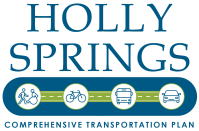Transit Survey
Transit Survey
The Town of Holly Springs is updating its Comprehensive Transportation Plan (CTP), which will identify strategies for improving how pedestrians, bicyclists, transit users and motorists get around Town. We want to hear your thoughts, because planning is incomplete without you!
Transit, also known as public transportation, includes buses and other shared vehicles and services that are open to the general public, run at scheduled times, and may require a fare. Transit improvements may include:
- Buses, bus stops, and bus shelters.
- Bus stop amenities including benches, trash receptacles and street lights.
- Pedestrian accesses and walkways.
- Bicycle accesses, including bicycle storage shelters and parking facilities, and the installation of equipment for transporting bicycles on public transportation vehicles.
- Enhanced access to public transportation for persons with disabilities.
- Park and Ride facilities.
- New routes or improvements to existing routes.
- Signage and more!
GoTriangle’s Route 305 provides week-day peak morning and evening transit services between Holly Springs and Raleigh, via Apex. For more information, visit https://goforwardnc.org/.
This is hidden text that lets us know when google translate runs.
